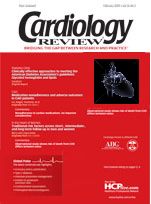Publication
Article
Cardiology Review® Online
Case report: Anemia in a patient with chronic heart failure
A 65-year-old man with ischemic cardiomyopathy and symptoms of worsening heart failure was examined in the cardiology outpatient clinic. The patient had been diagnosed with heart failure 6 years earlier and was receiving maximally tolerated doses of a diuretic, an angiotensin-converting enzyme inhibitor, and a beta blocking agent. His ejection fraction was 33%, and his hemoglobin concentration was 11.6 g/dL. Iron/transferrin saturation and B12, folate, and ferritin concentrations were all normal.
On examination, the patient was shown to be in New York Heart Association functional class 3, with a peak oxygen consumption (VO2) of 12.2 mL/kg/min (mean of two assessments performed 2 weeks apart), a maximal exercise duration of 482 seconds (assessed using a modified Naughton protocol), and a serum brain natriuretic peptide (BNP) concentration of 413 pg/mL. The patient entered a double-blind, randomized, placebo-controlled clinical trial examining the effect of hemoglobin optimization on functional status in chronic heart failure patients. He was randomly assigned to receive active treatment with darbepoetin alfa (Aranesp). Darbepoetin alfa is an erythropoiesis-stimulating protein that can be administered once every 2 weeks or once a month. It is currently only approved for the treatment of anemia associated with chronic renal failure and chemotherapy-induced anemia in patients with nonmyeloid malignancy.
Darbepoetin alfa was initiated at a dose of 0.75 µg/kg, administered by subcutaneous injection every 2 weeks. Hemoglobin concentration was monitored weekly. The dose of darbepoetin alfa was increased by 25% every 4 weeks to achieve an increase in hemoglobin concentration of between 0.5 and 1.5 g/dL every 3 weeks and a target hemoglobin concentration of 14 g/dL. The patient reached the target hemoglobin concentration after 13 weeks of treatment. The hemoglobin concentration was 13.8 g/dL 27 weeks after initiating treatment, and the patient’s functional status was both subjectively and objectively improved. Peak VO2 had increased by 2.2 mL/kg/min, to 14.4 mL/kg/min. Treadmill exercise duration had improved from 175 seconds to 657 seconds, and the patient’s BNP concentration had fallen by 77 pg/mL, to 336 pg/mL. At week 27, the patient was receiving 0.85 µg/kg of darbepoetin alfa every 2 weeks.
